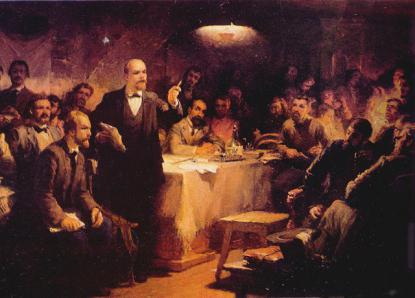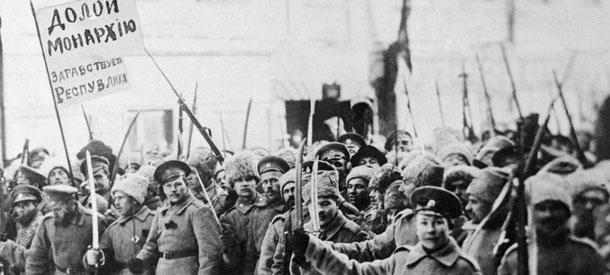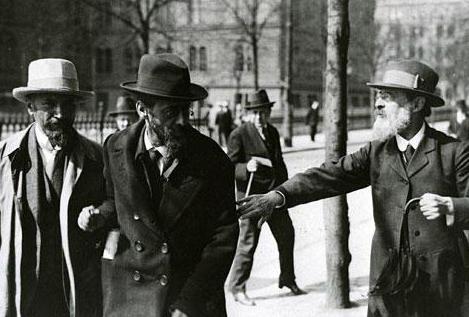Today, many experts in the field of promoting services and goods quite seriously argue that the leader of the proletarian revolution, V. I. Ulyanov, was the most talented marketer in the world. His genius consisted in the fact that he was able to "sell" to the broad masses the idea of universal equality, using short, gritty and intelligible slogans. Vladimir Ilyich managed to create concise and expressive symbols (sickle and hammer, five-pointed star) and determine the desired corporate color (red). But the main Leninist achievement was the choice of a brand. The idea that Bolshevism is something large, powerful, inevitable and unshakable has become firmly entrenched in the mass consciousness. But the Mensheviks are a trifle, in general, rubbish.
The creation of the brand of the most powerful political party of the 20th century took place in London, in 1903, in the summer.
When the Bolsheviks and Mensheviks appeared
The second party congress was held sequentially in two cities - Brussels and London. Obviously, the organizers were afraid of persecution and sought conspiracy, and therefore went on such an unusual step, like a break and a move. Lenin and Martov argued a lot and often, and the essence of their debate can be reduced to whether it is worth the wait when the apple itself falls, or is it better to pluck it? At least roughly with these words, the future leader of the Bolsheviks described the scheme of the contradictions that arose. One of the oldest members of the RSDLP and a major party theorist Martov didn’t want to eat unripe fruits, he didn’t want to pick the greens from the branches and, moreover, did not want to knock it off with a stick.

Both arguers at that time agreed that the revolution should be global, it will happen in countries with the most advanced industry, and only then it will spread to the backward kingdoms-states, including the Russian Empire. The only question was which methods to give preference to - legal or clandestine. After the vote, which led to the victory of the Leninist line, the party split into two parts. Lenin immediately called his supporters Bolsheviks, adding that Martov’s adherents were Mensheviks. To some extent, this determined the history of the 20th century.
First revolution
Special attention should be paid to the fact that the Bolsheviks did not always secure overwhelming quantitative superiority during party voting at the beginning of the turbulent twentieth century. The line they chose for clandestine terrorist work led to a split in the RSDLP. In the work of the Third Congress, which was also held in London (1905), Martov’s supporters did not want to participate, they perceived the tragic revolutionary events as a movement to the next stage of social development in Russia, that is, to the bourgeois republic, which corresponded to Marxist theory. Nevertheless, representatives of the March wing joined the armed uprisings, they acted on the battleship Potemkin and during other unrest. Thus, disagreements raged somewhere in the upper echelons of the party, but at the grassroots level did not play a big role. After the suppression of the disorder, Plekhanov spoke of him as a useless affair that should not have been started. The leader of the Mensheviks, Martov, agreed with this opinion.

War with japan
The Bolsheviks wished for the defeat of tsarist Russia and did everything in order to undermine the country's defense potential. This desire manifested itself most vividly during the German War, but was first formulated earlier - in the years of Japan. One of the reasons why the Mensheviks refused to participate in the Third London Congress of the RSDLP is the fact that they knew of material support from foreign hostile intelligence services. In condemning the war, the Martians could not allow the thought that freedom would come from abroad, and the Japanese would bring it on their bayonets. In addition, the Land of the Rising Sun at that time was socially and technically a rather backward state, and the promotion of its victories did not fit into elementary logic. And in general, the ideology of the Mensheviks, like the Bolsheviks, ruled out at that time the possibility of the victory of the revolution in one country.
Together again
In 1906, the leaders of both wings of the RSDLP gathered again for the congress, this time it was held in Stockholm. The parties recognized the need for joint work, and sought to smooth out the contradictions. The disagreements of the Mensheviks and Bolsheviks this time seemed not very significant and concerned only the wording of the first paragraph of the party charter. Martov proposed that the obligation to “assist” be left unchanged, while Lenin insisted on “personal participation” in a particular organization. At first glance, the difference is small, but in fact it turned out that it is of great importance. Lenin strove to create a strict hierarchically built military structure, and Martov was quite satisfied with the usual intellectual talk-shop. The leader of the Mensheviks considered the revolutionary transformations premature, offering to focus on the ideological treatment of the backward population of a vast agricultural country that was not ripe for socialism. Nevertheless, the Bolsheviks won another victory: the Leninist version of the first article of the Charter of the RSBRP (o) was approved.
Interwar contradictions
Formally, after the “unifying” Stockholm congress, the party gained solidity, but realities revealed the existence of remaining contradictions. The defeat of the revolution forced the Social-Democratic leadership to emigrate, despondency reigned in their ranks. Money was needed, but the Bolshevik methods of obtaining it caused an ambiguous reaction of eternal opponents - Martov, his brother Levitsky, Potresov, Axelrod and other Mensheviks. There was a movement of "liquidators" who expressed the view that it was necessary to completely curtail illegal work and stop the "exes" (that is, robberies), but it only covered a part of the supporters of milder actions (including Plekhanov), the rest took a wait and see stance, declaring their desire to unity. Trotsky in 1912 published the newspaper Pravda in Vienna, in which frankly anti-Leninist articles were published, and on the basis of the platform set forth by the main party printing organ, a conference called the Augustow Conference was created. The bloc formed after it suffered the same Menshevik vice, namely internal friction, and soon collapsed. The general requirements of civil liberties, representation in the IV State Duma of all sectors of society, etc., did not suit other participants in the revolutionary movement.
The defeatists and patriots
After the outbreak of World War II, the Menshevik program came into direct conflict with Bolshevik politics. Potresov, Plekhanov and other "defenders" did not consider it right to seek the death of the tsarist regime at the cost of a national tragedy. They condemned the war as such, calling it mutually aggressive, and then completely “slipped” to the recognition that the Russian army was only protecting its land. The camp of the RSDLP was divided into two parts: the "internationalists" and the "patriots" were distinguished by their attitude to the possible outcome of the hostilities at the front. The most extreme position was considered the goal of achieving their termination and removal of the warring parties "without annexations and indemnities." The defeat and escalation of hostilities into a civil conflict was desired by the Bolshevik wing of the RSDLP. The Mensheviks believed that the conclusion of peace in this situation could lead to a world revolution. They were wrong.

The February revolution actually became the implementation of the "minimum program", previously declared by the RSDLP as the goal for the coming decades.
The main points of Menshevik politics
So how did the Bolsheviks and Mensheviks differ? The party’s program, or rather, its March wing, consisted of the following points:
a) the seizure of power in a country with unstable conditions and prerequisites is useless, only the opposition struggle makes sense;
b) the Russian proletarian revolution does not happen soon, and only after its victory in the countries of Europe and the North American States;
c) the role of the liberal bourgeoisie in the struggle against autocracy is extremely important, and it is necessary to cooperate with it;
d) the peasantry - the class is backward, it should be used as an auxiliary power and ally, but you can not rely on it;
e) the proletariat — the main “locomotive” of the revolution (this point arose under the influence of Bolshevism);
e) preference is given to legal methods of struggle. Terrorism is unacceptable.
February
The Menshevik Party as an independent political force took shape in early 1917. At first glance, everything went according to the approved plan, the bourgeois republic arose on the ruins of the empire, and now it remains only to wait for the people to mature and want a new revolution, this time the proletarian. The trouble was that the dramatic events of February 1917 took the RSDLP leadership by surprise. The Mensheviks, like the Bolsheviks, did not control its progress, did not take part in organizing the overthrow of the tsar, and now they painfully tried to use the situation as efficiently as possible to realize their program goals. The Martovians quickly orientated themselves. The Provisional Government was formed, and they delegated their representatives to it. There were three Mensheviks in the new power structure (A. M. Nikitin, K. A. Gvozdev, P. N. Malyantovich), N. S. Chkheidze headed the Petrosoviet, and then, in June, after the First All-Russian Congress of Soviets, he even took over the chair All-Russian Central Executive Committee. The party’s position continued to strengthen, and its influence on the masses expanded.
The Menshevik party, despite the obvious successes, again fell ill with its ailment typical of it: its forces were divided into three currents. The right-wingers (represented by Potresov) took extreme patriotic positions, the centrists (Dan, Tsereteli) reserved the right to continue revolutionary work in the conditions of bourgeois democracy, but only after defeating an external enemy, and the left-wingers (Martov) condemned participation in the work of the Provisional Government, demanded the immediate distribution of land and the conclusion of peace.
Before the new revolution
Immediately before the October Revolution, many prominent Mensheviks left the party ranks. The party’s program, with its fuzziness, repelled possible followers and hesitants, including Yuri Larin, Leon Trotsky, and even Plekhanov himself. The process of political migration has become widespread, about 4 thousand Petrograd centrists - "Mezhrayontsi" joined the Leninist wing of the RSDLP in the spring of 1917. The reasons for this behavior were compelling: the ideology of the Mensheviks was discredited by the support of the war, from which the population, disoriented by active Bolshevik propaganda, was simply tired. In addition, there was a frequent contradiction between political goals and a certain honesty of the party leadership, which did not dare to promise the people that it was not able to fulfill. The game for power was lost, and in October the Mensheviks fully understood this.
Coup
October 25, there was a coup and seizure of power by the Bolsheviks. The Central Committee of the RSDLP (o) immediately drafted a condemning resolution, calling these actions usurps, but it was too late. Internal unity and sequence of actions were still not observed. The calls to create a new government, "homogeneous", representing all political movements on an equal footing, and to support the Constituent Assembly did not lead to anything. Ten members of the Central Committee and three candidates left the party ranks. An extraordinary emergency congress of the RSDLP (o) was convened, but it also remained inconclusive, except for the dispersal of the Constituent Assembly by the Bolsheviks at the very beginning of 1918. Then the Civil War began, during which the right-wing Mensheviks, led by V.O. Levitsky, V.N. Rozanov and A.N. Potresov, took a position that was extremely hostile to the new authorities.
For or against Soviet power?
During the Civil War, the leaders of the RSDLP (o) took an active part in the power structures created in territories beyond the control of the Bolsheviks. Then the Mensheviks changed the name of the party and began to call themselves simply Russian Social Democrats, without any letters in brackets. They held ministerial posts in the Samara COMUCH, the interim Siberian government, the Central Caspian, the Ufa meeting, and the Ural regional government. In 1918, they (the SPD) actually seized power in Georgia after the declaration of a democratic republic there. In response, the Bolsheviks expelled representatives of the RSDLP from all councils. However, already in August 1918, the Menshevik party was partially rehabilitated as having abandoned the coalition with bourgeois associations.
The rout of Menshevism
The repression continued in the spring of 1919, after the Bolshevik positions were strengthened during the Civil War. In Kiev, Odessa, and then in Georgia, the Cheka conducted large-scale purges of identified members of the RSDLP. In collaboration with the Denikin Volunteer Army, the Bolsheviks accused them. The Mensheviks, Socialist-Revolutionaries, Cadets and representatives of other parties were isolated, in some cases (not infrequent) they were shot, and their leaders were "settled" with the goal of neutralizing them. What this term meant is not known for certain, but you can guess. Yu. Martov and R. Abramovich were lucky: they managed to escape from the country in 1920. Two years later, another leader of the Russian social dedeks, the Menshevik F. Dan, was sent abroad. Then in Moscow, a whole group of the youth wing of the RSDLP was arrested, an open trial was being prepared over it, but, in the end, Soviet justice was limited to exile. Repression led to the almost complete defeat of Menshevism; individual cells that went underground survived until 1925.
What happened to the Mensheviks later
The fate of the Mensheviks who found themselves in exile is unenviable. Attempts to publish their own periodicals proved to be extremely costly; the “fathers of Russian democracy” who settled in Germany in 1933 were forced to move to France and then to America. But the unsuccessful “brand” became a kind of stigma for those who remained in the USSR and for one reason or another turned out to be objectionable to the Stalinist leadership. If necessary, any member of the party could recall his Menshevik past, present or imaginary. The first high-profile process took place in 1931: on charges of creating a counter-revolutionary organization, 14 employees of the State Planning Commission and the State Bank were sentenced to long terms of imprisonment.

However, not all the former Mensheviks, the Bolshevik party treated so severely. Prosecutor General Vyshinsky, diplomats A. A. Troyanovsky and M. Maisky and some other members of the disgraced organization lived their lives quite well. Although above them their past hung with a sword of Damocles.